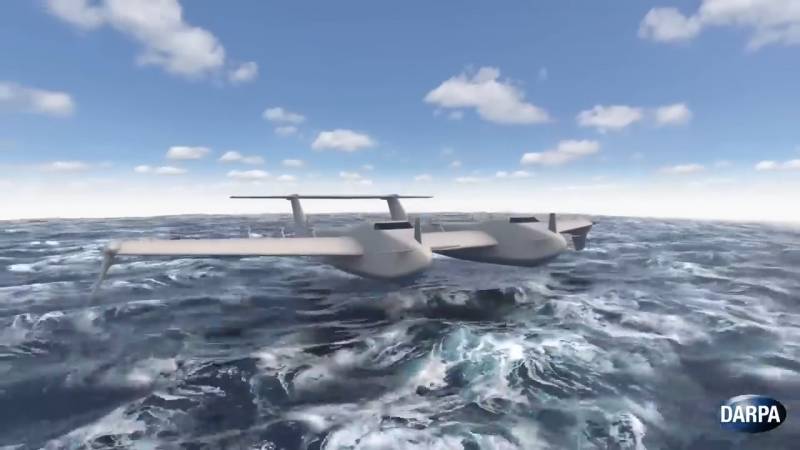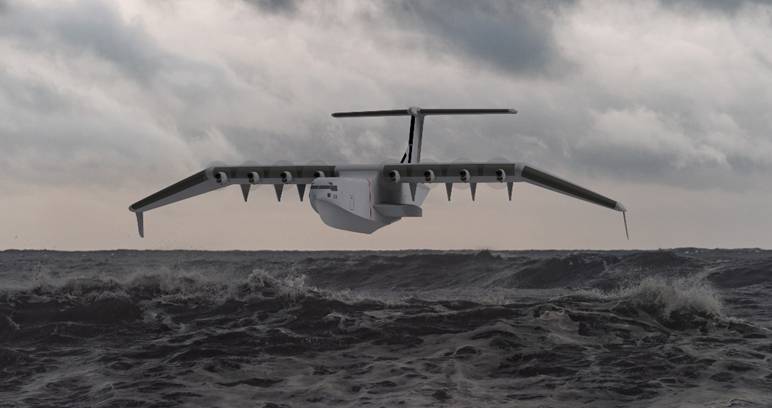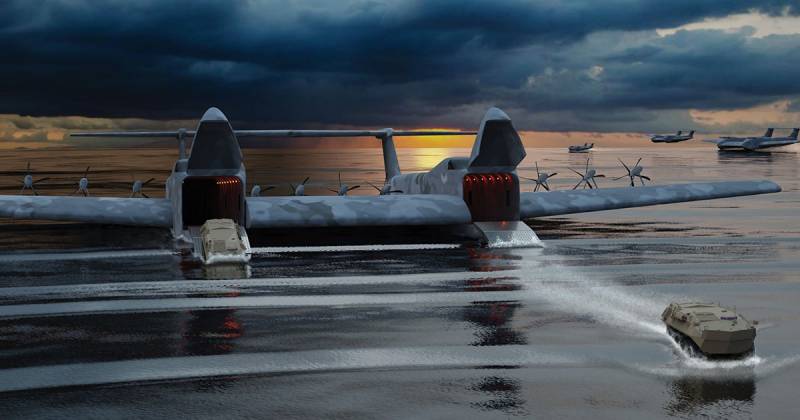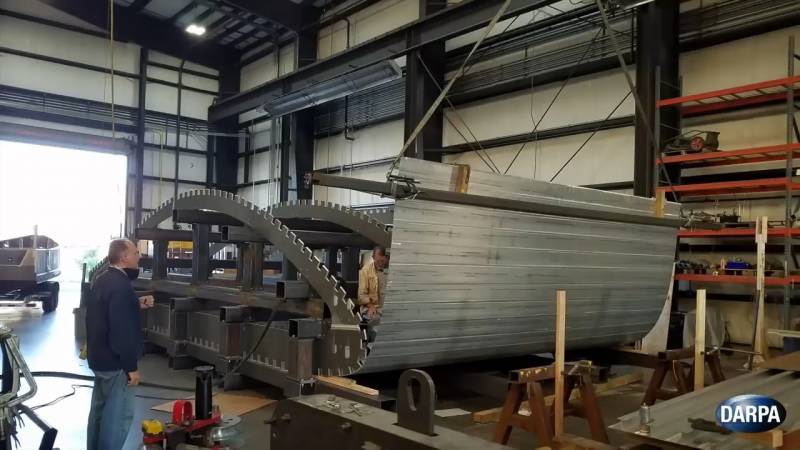DARPA begins competitive development of the Liberty Lifter ekranoplan

WIG variant from GA-ASI
The Pentagon has been showing interest in ekranoplans for a long time and is conducting some research in this area. A few months ago, it was decided to create such a vehicle with an eye on real operation in the distant future. The ekranoplan development program was called the Liberty Lifter and is being implemented under the leadership of the DARPA agency.
In the early stages
The Liberty Lifter program launched in May 2022 at the initiative of the Pentagon. By this time, its main goals and objectives were determined, and some technical requirements were also formed. In the near future, DARPA planned to collect applications and proposals from potential participants. Over the next few months, the most successful concepts for further development were to be determined.
As reported, the goal of the Liberty Lifter program is to create a military transport ekranoplan with a high payload and high flight characteristics. With its help, in the future it is planned to transfer various cargoes at the tactical and strategic level. Depending on the situation and situation, the ekranoplan will complement or replace aircraft and ships.
The aircraft will take off from the water, carry out high-speed flight at low altitude and perform landing on the water. Such principles of operation, in theory, allow you to gain advantages over other vehicles. Thus, the ekranoplan is much faster than any surface vessel, and military transport aircraft of traditional design lose to it in theoretical carrying capacity and have limitations in basing. Also, the ekranoplan will be able to supplement the existing landing craft of the Marine Corps.

Competition project from Aurora Flight Science
In May, the first phase of the Liberty Lifter program was launched. Its purpose was to search for technical proposals and preliminary study of projects. It was also planned to determine the possible level of performance characteristics achievable using available technologies.
There are several additional requirements for the ekranoplan. So, an aircraft may have an unusual design, but it should be simplified as much as possible. Also, only accessible components and assemblies should be used. Designing complex systems and assemblies from scratch or applying overly complex concepts is not recommended.
It is necessary to obtain high flight performance. Thus, a high resistance of the aircraft to waves is required, both in takeoff and landing modes and in flight. The flight must be carried out over water and at altitudes up to 10 thousand feet (3 km). The ekranoplan should be able to operate for a long time (up to several weeks) at sea without full maintenance. The issue of navigation and safe driving in navigable areas will be worked out to prevent collisions or other incidents.
Competitive stage
According to known data, several American companies, mainly from the aircraft industry, responded to the invitation of the DARPA agency. By the end of last year, the agency began analyzing technical proposals and has now chosen the most successful ones. The winners of the first stage of the program were announced on February 1.
Two presented projects will be further developed. The first was developed by General Atomics Aeronautical Systems, Inc. in collaboration with Maritime Applied Physics Corporation, and the second is offered by Aurora Flight Sciences, which has joined forces with Gibbs & Cox and ReconCraft. Two teams receive contracts for further work.

Ekranoplan from GA-ASI lands troops
The new agreements establish a work plan for the next 18 months. In the next 6 months participants in the program will further develop their concepts. Then 9 months. allocated to full technical design. Another three months are given to prepare the production of experimental equipment and plan subsequent tests.
All of these activities should be completed by the fall of 2024. DARPA will then review the submitted materials and select the winner of the program. He will receive a major contract to complete the design, construction and testing of experimental equipment. The timing of the completion of these works can not yet be called.
Several other organizations and Pentagon structures are expected to join the Liberty Lifter program after the winner is selected. In addition, the program may attract the attention of US foreign partners interested in obtaining a fundamentally new transport. Probably, the project will be completed by joint efforts.
Two options
General Atomics and Aurora have already shown the approximate appearance of the ekranoplanes being developed and some of their capabilities. The exact level of design characteristics is still unknown - probably due to the insufficient degree of project development. Nevertheless, the published materials also make it possible to understand how the two development teams intend to solve the set technical problems.

GA-ASI offers an ekranoplan of an unusual appearance. It is proposed to equip it with two fuselages connected by a low-lying large-span wing and empennage with an upper stabilizer. Both fuselages must accommodate large cargo compartments with front entry - the nose cones fold up. The power plant is proposed to be composed of 10-12 turboprop engines on pylons above the wing.
Aurora Flight Science offers a more familiar layout and architecture. Her ekranoplan Liberty Lifter is actually a large "flying boat" with one fuselage. It has a high-lying wing with inclined consoles and vertical tips. Under the planes on the pylons placed four turbojet engines. Despite the "airplane" appearance, such an ekranoplan is optimized specifically for low-altitude flight.
It is noted that both concepts are similar in size to the serial C-17 Globemaster military transport aircraft. This means that the wingspan is in the range of 50-52 m, and the total length does not exceed 53-55 m. Also, the estimated carrying capacity of ekranoplans is compared with the C-17. The aircraft is capable of carrying 77,5 tons of cargo - people, equipment, property on pallets, etc. Similar opportunities should be given to technicians from GA-ASI and Aurora.
Technical tasks
The Pentagon is seriously interested in the subject of ekranoplans and even launched a full-fledged program aimed at conducting the necessary research and designing equipment. Over the next one and a half to two years, it will give the first results, as well as show its potential for further development. At the same time, a decision will be made on the need to continue work - or to close the program.

Assembly of structural elements for preliminary tests
The Pentagon's interest in the concept of ekranoplanes is quite understandable. Research and practical experience, incl. foreign, primarily Soviet / Russian, show that such equipment has certain advantages over vehicles of other classes. An aircraft flying at a low altitude above the water, according to one or another indicator, bypasses both sea vessels and full-fledged transport aircraft.
At the same time, the ekranoplan has its own specific features, and its creation is not an easy task. Because of this, the participants in the Liberty Lifter program were faced with several difficult tasks, which in general boil down to creating a design with the optimal combination of various characteristics. So, the ekranoplan should be roomy, but at the same time fit into the calculated weight restrictions. With all this, it must be resistant to waves and splashes. Finally, high speed characteristics and the ability to fly at high altitude are required of it.
The companies participating in the program have already proposed their own versions of such an aircraft, and their projects are radically different from each other. One of them uses the traditional layout of the aircraft, while the other uses an unusual architecture with two fuselages. Both versions of the ekranoplan should have certain advantages - but disadvantages or limitations are not excluded. Apparently, the same will be the case with other features of the projects.
Plans for the future
In recent months, the DARPA program to develop the Liberty Lifter ekranoplan has passed the first stage of searching and considering preliminary technical proposals. Now the circle of its participants has been determined, and they will have to develop full-fledged projects. In the second half of 2024, the customer will compare them and choose the best one.
This project will be developed and may even reach the construction and testing of a prototype. With a favorable development of events, the tests will be followed by an order for full-fledged production and the gradual introduction of a new ekranoplan in the troops. However, another scenario cannot yet be ruled out. Having studied two projects, the customer may be disappointed in the whole direction and stop the development of new ekranoplanes. How exactly events will develop will become known only in a year and a half.
Information